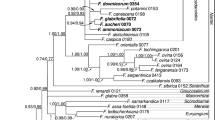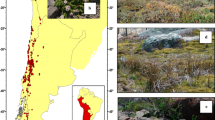Abstract.
The phylogenetic position of Parasitaxus (Podocarpaceae) has been inferred from a cladistic analysis of molecular characters from chloroplast and nuclear genomes including all genera of Podocarpaceae. In all 24 most parsimonious trees, based on combined datasets, Phyllocladus resided outside Podocarpaceae s. str. while Lepidothamnus was basal to the latter. Most other genera were arranged in two major clades. The evidence confirms previous studies, which have suggested a relationship between Lagarostrobos, Manoao and Parasitaxus. Parasitaxus is not directly related to its host Falcatifolium taxoides. Instead it appears to be most closely related to Manoao and Lagarostrobos. No other members of this group now occur on New Caledonia. However, if the evolution of Parasitaxus were autochthonous, a free-living member of this group must once have occurred there. An accelerated evolutionary rate of the chloroplast sequence analysed was suggested, indicating that the plant behaves like a holoparasite.
Similar content being viewed by others
Author information
Authors and Affiliations
Additional information
Received January 4, 2002; accepted April 3, 2002 Published online: September 13, 2002
Rights and permissions
About this article
Cite this article
Sinclair, W., Mill, R., Gardner, M. et al. Evolutionary relationships of the New Caledonian heterotrophic conifer, Parasitaxus usta (Podocarpaceae), inferred from chloroplast trnL-F intron/spacer and nuclear rDNA ITS2 sequences. Plant Syst. Evol. 233, 79–104 (2002). https://doi.org/10.1007/s00606-002-0199-8
Issue Date:
DOI: https://doi.org/10.1007/s00606-002-0199-8




